Role of Accounting and Finance Departments in Tesco: Financial Decision Making
VerifiedAdded on 2023/06/10
|12
|4103
|132
AI Summary
This report explains the role of accounting and finance departments in Tesco and the utility of financial ratios to the company as well as the potential investors. Various ratios are calculated and on the basis of such calculations, valued interpretations are drawn to form a basis for the decision making regarding investment for the potential investors’ perspective.
Contribute Materials
Your contribution can guide someone’s learning journey. Share your
documents today.

Financial Decision Making
Secure Best Marks with AI Grader
Need help grading? Try our AI Grader for instant feedback on your assignments.
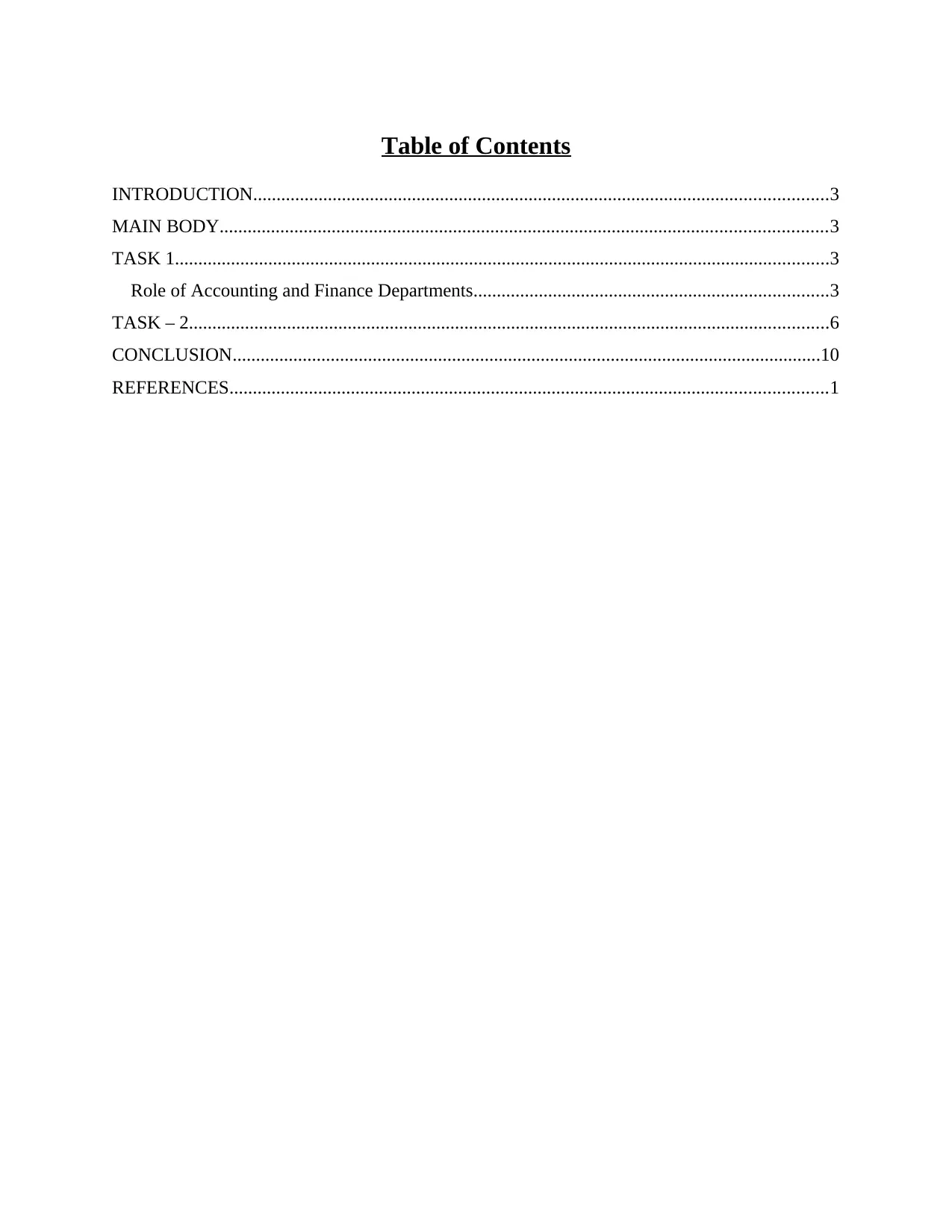
Table of Contents
INTRODUCTION...........................................................................................................................3
MAIN BODY..................................................................................................................................3
TASK 1............................................................................................................................................3
Role of Accounting and Finance Departments............................................................................3
TASK – 2.........................................................................................................................................6
CONCLUSION..............................................................................................................................10
REFERENCES................................................................................................................................1
INTRODUCTION...........................................................................................................................3
MAIN BODY..................................................................................................................................3
TASK 1............................................................................................................................................3
Role of Accounting and Finance Departments............................................................................3
TASK – 2.........................................................................................................................................6
CONCLUSION..............................................................................................................................10
REFERENCES................................................................................................................................1
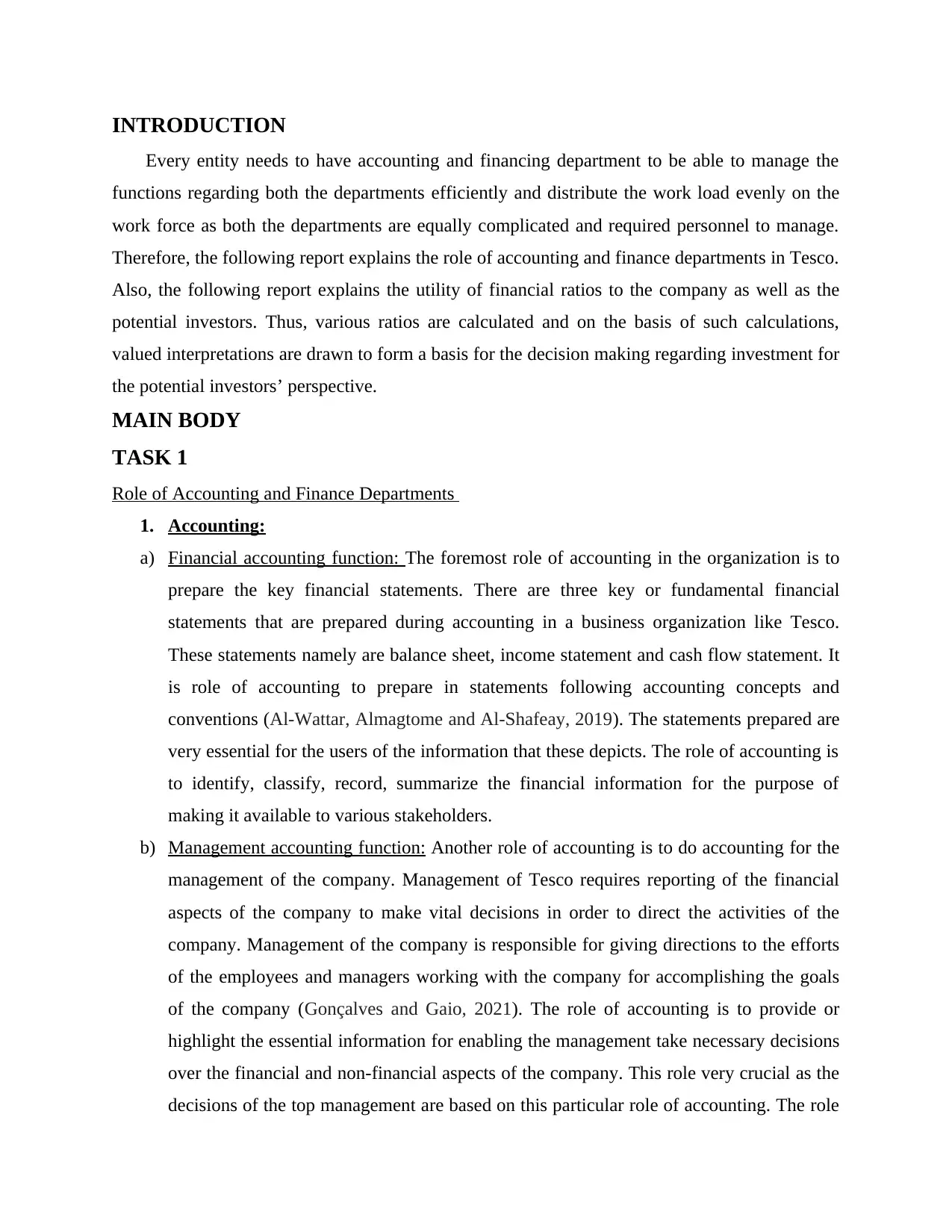
INTRODUCTION
Every entity needs to have accounting and financing department to be able to manage the
functions regarding both the departments efficiently and distribute the work load evenly on the
work force as both the departments are equally complicated and required personnel to manage.
Therefore, the following report explains the role of accounting and finance departments in Tesco.
Also, the following report explains the utility of financial ratios to the company as well as the
potential investors. Thus, various ratios are calculated and on the basis of such calculations,
valued interpretations are drawn to form a basis for the decision making regarding investment for
the potential investors’ perspective.
MAIN BODY
TASK 1
Role of Accounting and Finance Departments
1. Accounting:
a) Financial accounting function: The foremost role of accounting in the organization is to
prepare the key financial statements. There are three key or fundamental financial
statements that are prepared during accounting in a business organization like Tesco.
These statements namely are balance sheet, income statement and cash flow statement. It
is role of accounting to prepare in statements following accounting concepts and
conventions (Al-Wattar, Almagtome and Al-Shafeay, 2019). The statements prepared are
very essential for the users of the information that these depicts. The role of accounting is
to identify, classify, record, summarize the financial information for the purpose of
making it available to various stakeholders.
b) Management accounting function: Another role of accounting is to do accounting for the
management of the company. Management of Tesco requires reporting of the financial
aspects of the company to make vital decisions in order to direct the activities of the
company. Management of the company is responsible for giving directions to the efforts
of the employees and managers working with the company for accomplishing the goals
of the company (Gonçalves and Gaio, 2021). The role of accounting is to provide or
highlight the essential information for enabling the management take necessary decisions
over the financial and non-financial aspects of the company. This role very crucial as the
decisions of the top management are based on this particular role of accounting. The role
Every entity needs to have accounting and financing department to be able to manage the
functions regarding both the departments efficiently and distribute the work load evenly on the
work force as both the departments are equally complicated and required personnel to manage.
Therefore, the following report explains the role of accounting and finance departments in Tesco.
Also, the following report explains the utility of financial ratios to the company as well as the
potential investors. Thus, various ratios are calculated and on the basis of such calculations,
valued interpretations are drawn to form a basis for the decision making regarding investment for
the potential investors’ perspective.
MAIN BODY
TASK 1
Role of Accounting and Finance Departments
1. Accounting:
a) Financial accounting function: The foremost role of accounting in the organization is to
prepare the key financial statements. There are three key or fundamental financial
statements that are prepared during accounting in a business organization like Tesco.
These statements namely are balance sheet, income statement and cash flow statement. It
is role of accounting to prepare in statements following accounting concepts and
conventions (Al-Wattar, Almagtome and Al-Shafeay, 2019). The statements prepared are
very essential for the users of the information that these depicts. The role of accounting is
to identify, classify, record, summarize the financial information for the purpose of
making it available to various stakeholders.
b) Management accounting function: Another role of accounting is to do accounting for the
management of the company. Management of Tesco requires reporting of the financial
aspects of the company to make vital decisions in order to direct the activities of the
company. Management of the company is responsible for giving directions to the efforts
of the employees and managers working with the company for accomplishing the goals
of the company (Gonçalves and Gaio, 2021). The role of accounting is to provide or
highlight the essential information for enabling the management take necessary decisions
over the financial and non-financial aspects of the company. This role very crucial as the
decisions of the top management are based on this particular role of accounting. The role
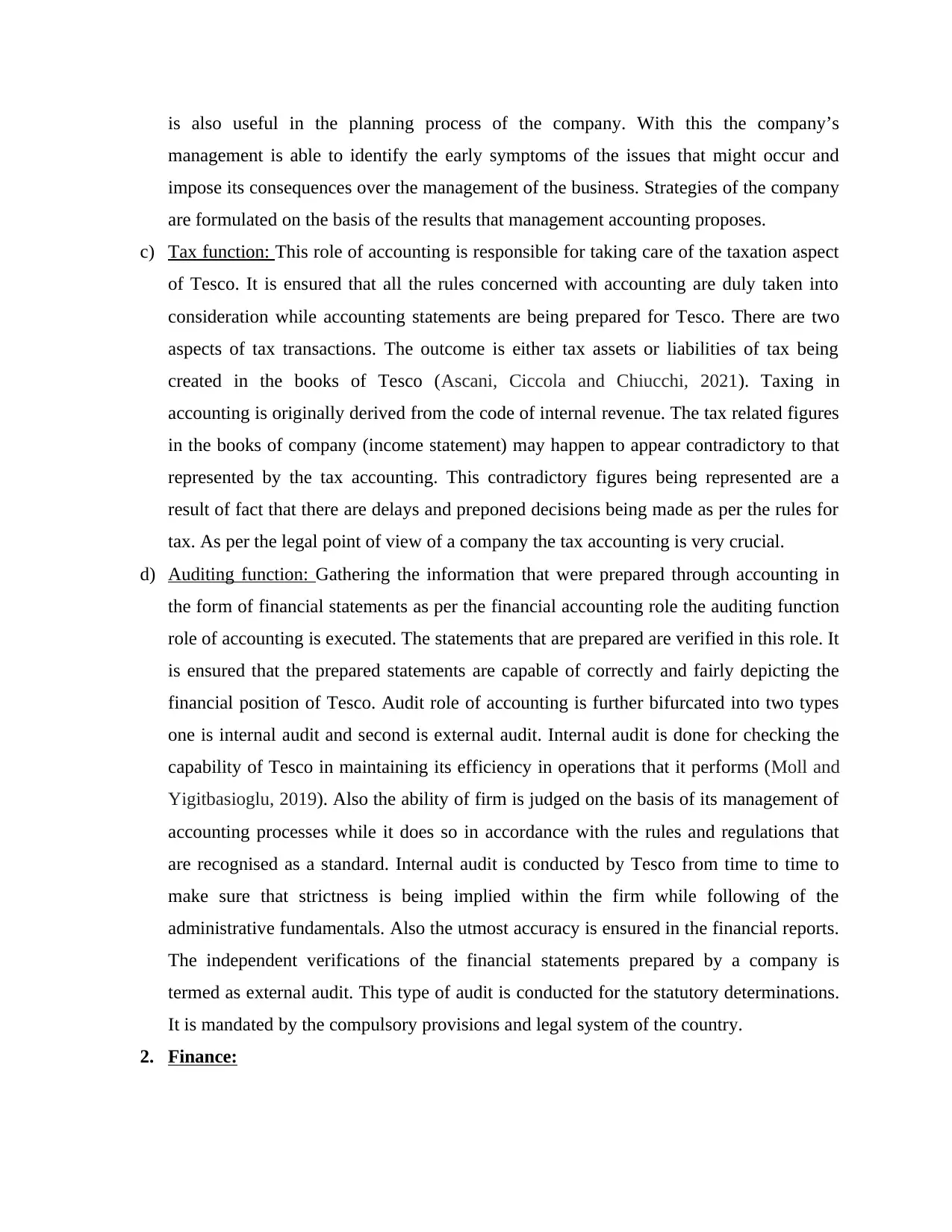
is also useful in the planning process of the company. With this the company’s
management is able to identify the early symptoms of the issues that might occur and
impose its consequences over the management of the business. Strategies of the company
are formulated on the basis of the results that management accounting proposes.
c) Tax function: This role of accounting is responsible for taking care of the taxation aspect
of Tesco. It is ensured that all the rules concerned with accounting are duly taken into
consideration while accounting statements are being prepared for Tesco. There are two
aspects of tax transactions. The outcome is either tax assets or liabilities of tax being
created in the books of Tesco (Ascani, Ciccola and Chiucchi, 2021). Taxing in
accounting is originally derived from the code of internal revenue. The tax related figures
in the books of company (income statement) may happen to appear contradictory to that
represented by the tax accounting. This contradictory figures being represented are a
result of fact that there are delays and preponed decisions being made as per the rules for
tax. As per the legal point of view of a company the tax accounting is very crucial.
d) Auditing function: Gathering the information that were prepared through accounting in
the form of financial statements as per the financial accounting role the auditing function
role of accounting is executed. The statements that are prepared are verified in this role. It
is ensured that the prepared statements are capable of correctly and fairly depicting the
financial position of Tesco. Audit role of accounting is further bifurcated into two types
one is internal audit and second is external audit. Internal audit is done for checking the
capability of Tesco in maintaining its efficiency in operations that it performs (Moll and
Yigitbasioglu, 2019). Also the ability of firm is judged on the basis of its management of
accounting processes while it does so in accordance with the rules and regulations that
are recognised as a standard. Internal audit is conducted by Tesco from time to time to
make sure that strictness is being implied within the firm while following of the
administrative fundamentals. Also the utmost accuracy is ensured in the financial reports.
The independent verifications of the financial statements prepared by a company is
termed as external audit. This type of audit is conducted for the statutory determinations.
It is mandated by the compulsory provisions and legal system of the country.
2. Finance:
management is able to identify the early symptoms of the issues that might occur and
impose its consequences over the management of the business. Strategies of the company
are formulated on the basis of the results that management accounting proposes.
c) Tax function: This role of accounting is responsible for taking care of the taxation aspect
of Tesco. It is ensured that all the rules concerned with accounting are duly taken into
consideration while accounting statements are being prepared for Tesco. There are two
aspects of tax transactions. The outcome is either tax assets or liabilities of tax being
created in the books of Tesco (Ascani, Ciccola and Chiucchi, 2021). Taxing in
accounting is originally derived from the code of internal revenue. The tax related figures
in the books of company (income statement) may happen to appear contradictory to that
represented by the tax accounting. This contradictory figures being represented are a
result of fact that there are delays and preponed decisions being made as per the rules for
tax. As per the legal point of view of a company the tax accounting is very crucial.
d) Auditing function: Gathering the information that were prepared through accounting in
the form of financial statements as per the financial accounting role the auditing function
role of accounting is executed. The statements that are prepared are verified in this role. It
is ensured that the prepared statements are capable of correctly and fairly depicting the
financial position of Tesco. Audit role of accounting is further bifurcated into two types
one is internal audit and second is external audit. Internal audit is done for checking the
capability of Tesco in maintaining its efficiency in operations that it performs (Moll and
Yigitbasioglu, 2019). Also the ability of firm is judged on the basis of its management of
accounting processes while it does so in accordance with the rules and regulations that
are recognised as a standard. Internal audit is conducted by Tesco from time to time to
make sure that strictness is being implied within the firm while following of the
administrative fundamentals. Also the utmost accuracy is ensured in the financial reports.
The independent verifications of the financial statements prepared by a company is
termed as external audit. This type of audit is conducted for the statutory determinations.
It is mandated by the compulsory provisions and legal system of the country.
2. Finance:
Secure Best Marks with AI Grader
Need help grading? Try our AI Grader for instant feedback on your assignments.
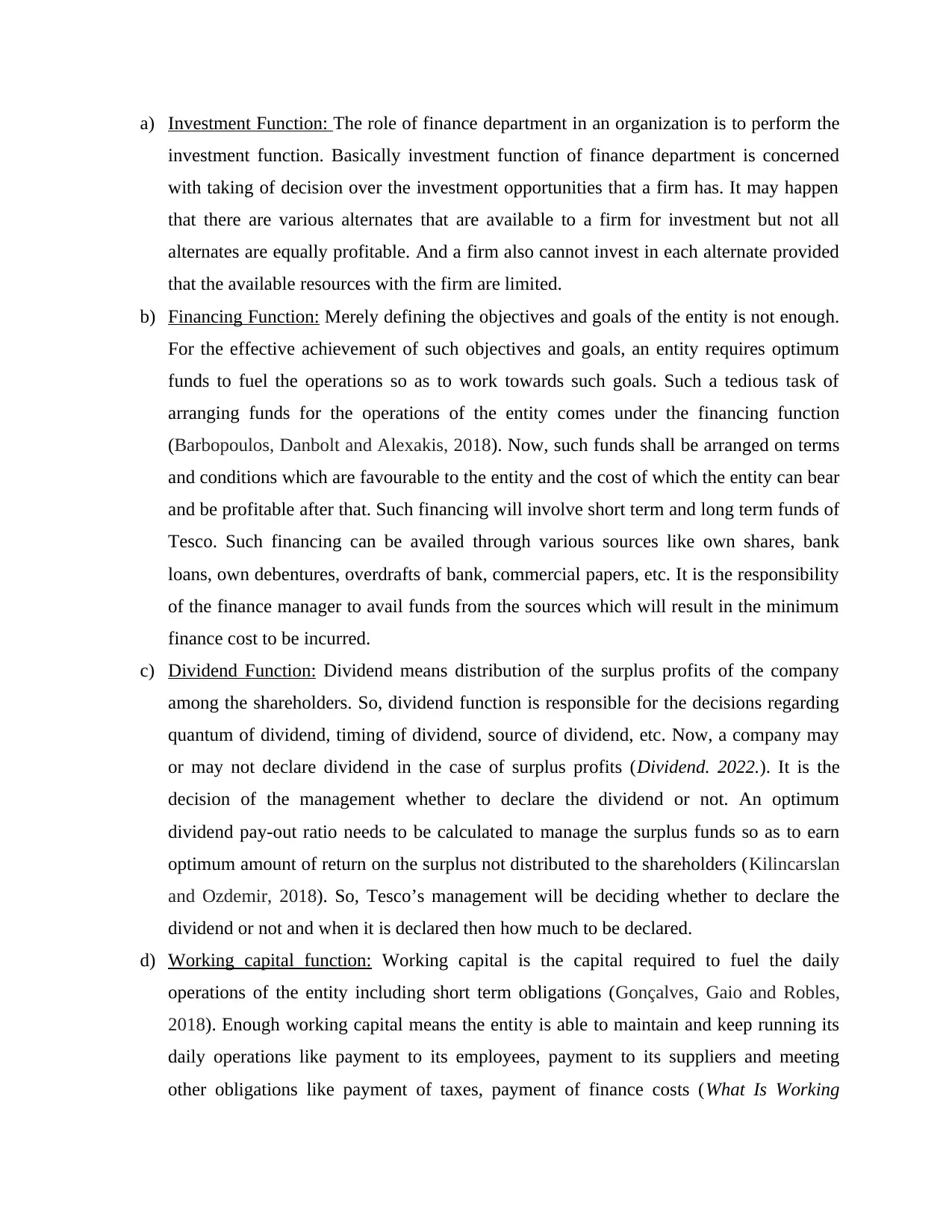
a) Investment Function: The role of finance department in an organization is to perform the
investment function. Basically investment function of finance department is concerned
with taking of decision over the investment opportunities that a firm has. It may happen
that there are various alternates that are available to a firm for investment but not all
alternates are equally profitable. And a firm also cannot invest in each alternate provided
that the available resources with the firm are limited.
b) Financing Function: Merely defining the objectives and goals of the entity is not enough.
For the effective achievement of such objectives and goals, an entity requires optimum
funds to fuel the operations so as to work towards such goals. Such a tedious task of
arranging funds for the operations of the entity comes under the financing function
(Barbopoulos, Danbolt and Alexakis, 2018). Now, such funds shall be arranged on terms
and conditions which are favourable to the entity and the cost of which the entity can bear
and be profitable after that. Such financing will involve short term and long term funds of
Tesco. Such financing can be availed through various sources like own shares, bank
loans, own debentures, overdrafts of bank, commercial papers, etc. It is the responsibility
of the finance manager to avail funds from the sources which will result in the minimum
finance cost to be incurred.
c) Dividend Function: Dividend means distribution of the surplus profits of the company
among the shareholders. So, dividend function is responsible for the decisions regarding
quantum of dividend, timing of dividend, source of dividend, etc. Now, a company may
or may not declare dividend in the case of surplus profits (Dividend. 2022.). It is the
decision of the management whether to declare the dividend or not. An optimum
dividend pay-out ratio needs to be calculated to manage the surplus funds so as to earn
optimum amount of return on the surplus not distributed to the shareholders (Kilincarslan
and Ozdemir, 2018). So, Tesco’s management will be deciding whether to declare the
dividend or not and when it is declared then how much to be declared.
d) Working capital function: Working capital is the capital required to fuel the daily
operations of the entity including short term obligations (Gonçalves, Gaio and Robles,
2018). Enough working capital means the entity is able to maintain and keep running its
daily operations like payment to its employees, payment to its suppliers and meeting
other obligations like payment of taxes, payment of finance costs (What Is Working
investment function. Basically investment function of finance department is concerned
with taking of decision over the investment opportunities that a firm has. It may happen
that there are various alternates that are available to a firm for investment but not all
alternates are equally profitable. And a firm also cannot invest in each alternate provided
that the available resources with the firm are limited.
b) Financing Function: Merely defining the objectives and goals of the entity is not enough.
For the effective achievement of such objectives and goals, an entity requires optimum
funds to fuel the operations so as to work towards such goals. Such a tedious task of
arranging funds for the operations of the entity comes under the financing function
(Barbopoulos, Danbolt and Alexakis, 2018). Now, such funds shall be arranged on terms
and conditions which are favourable to the entity and the cost of which the entity can bear
and be profitable after that. Such financing will involve short term and long term funds of
Tesco. Such financing can be availed through various sources like own shares, bank
loans, own debentures, overdrafts of bank, commercial papers, etc. It is the responsibility
of the finance manager to avail funds from the sources which will result in the minimum
finance cost to be incurred.
c) Dividend Function: Dividend means distribution of the surplus profits of the company
among the shareholders. So, dividend function is responsible for the decisions regarding
quantum of dividend, timing of dividend, source of dividend, etc. Now, a company may
or may not declare dividend in the case of surplus profits (Dividend. 2022.). It is the
decision of the management whether to declare the dividend or not. An optimum
dividend pay-out ratio needs to be calculated to manage the surplus funds so as to earn
optimum amount of return on the surplus not distributed to the shareholders (Kilincarslan
and Ozdemir, 2018). So, Tesco’s management will be deciding whether to declare the
dividend or not and when it is declared then how much to be declared.
d) Working capital function: Working capital is the capital required to fuel the daily
operations of the entity including short term obligations (Gonçalves, Gaio and Robles,
2018). Enough working capital means the entity is able to maintain and keep running its
daily operations like payment to its employees, payment to its suppliers and meeting
other obligations like payment of taxes, payment of finance costs (What Is Working
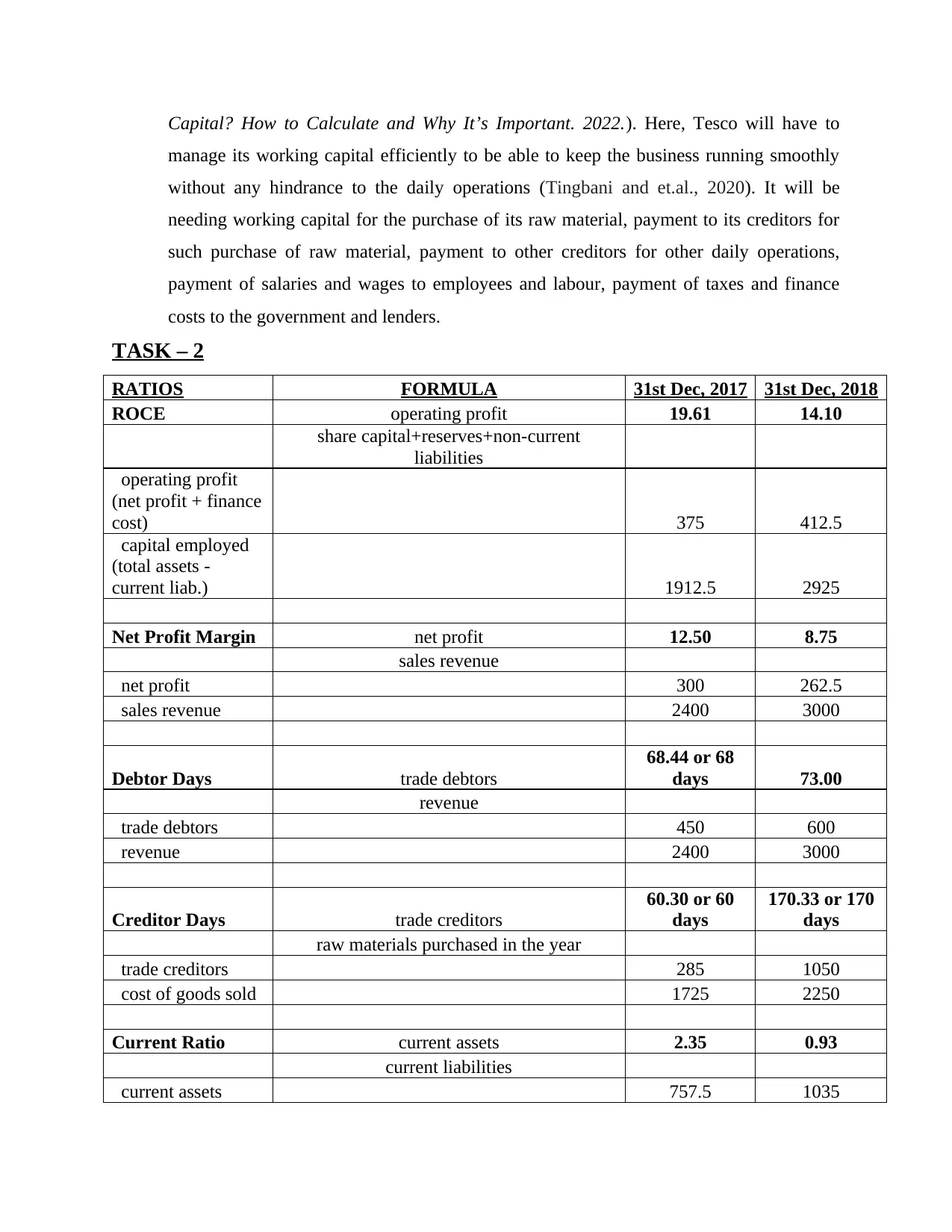
Capital? How to Calculate and Why It’s Important. 2022.). Here, Tesco will have to
manage its working capital efficiently to be able to keep the business running smoothly
without any hindrance to the daily operations (Tingbani and et.al., 2020). It will be
needing working capital for the purchase of its raw material, payment to its creditors for
such purchase of raw material, payment to other creditors for other daily operations,
payment of salaries and wages to employees and labour, payment of taxes and finance
costs to the government and lenders.
TASK – 2
RATIOS FORMULA 31st Dec, 2017 31st Dec, 2018
ROCE operating profit 19.61 14.10
share capital+reserves+non-current
liabilities
operating profit
(net profit + finance
cost) 375 412.5
capital employed
(total assets -
current liab.) 1912.5 2925
Net Profit Margin net profit 12.50 8.75
sales revenue
net profit 300 262.5
sales revenue 2400 3000
Debtor Days trade debtors
68.44 or 68
days 73.00
revenue
trade debtors 450 600
revenue 2400 3000
Creditor Days trade creditors
60.30 or 60
days
170.33 or 170
days
raw materials purchased in the year
trade creditors 285 1050
cost of goods sold 1725 2250
Current Ratio current assets 2.35 0.93
current liabilities
current assets 757.5 1035
manage its working capital efficiently to be able to keep the business running smoothly
without any hindrance to the daily operations (Tingbani and et.al., 2020). It will be
needing working capital for the purchase of its raw material, payment to its creditors for
such purchase of raw material, payment to other creditors for other daily operations,
payment of salaries and wages to employees and labour, payment of taxes and finance
costs to the government and lenders.
TASK – 2
RATIOS FORMULA 31st Dec, 2017 31st Dec, 2018
ROCE operating profit 19.61 14.10
share capital+reserves+non-current
liabilities
operating profit
(net profit + finance
cost) 375 412.5
capital employed
(total assets -
current liab.) 1912.5 2925
Net Profit Margin net profit 12.50 8.75
sales revenue
net profit 300 262.5
sales revenue 2400 3000
Debtor Days trade debtors
68.44 or 68
days 73.00
revenue
trade debtors 450 600
revenue 2400 3000
Creditor Days trade creditors
60.30 or 60
days
170.33 or 170
days
raw materials purchased in the year
trade creditors 285 1050
cost of goods sold 1725 2250
Current Ratio current assets 2.35 0.93
current liabilities
current assets 757.5 1035
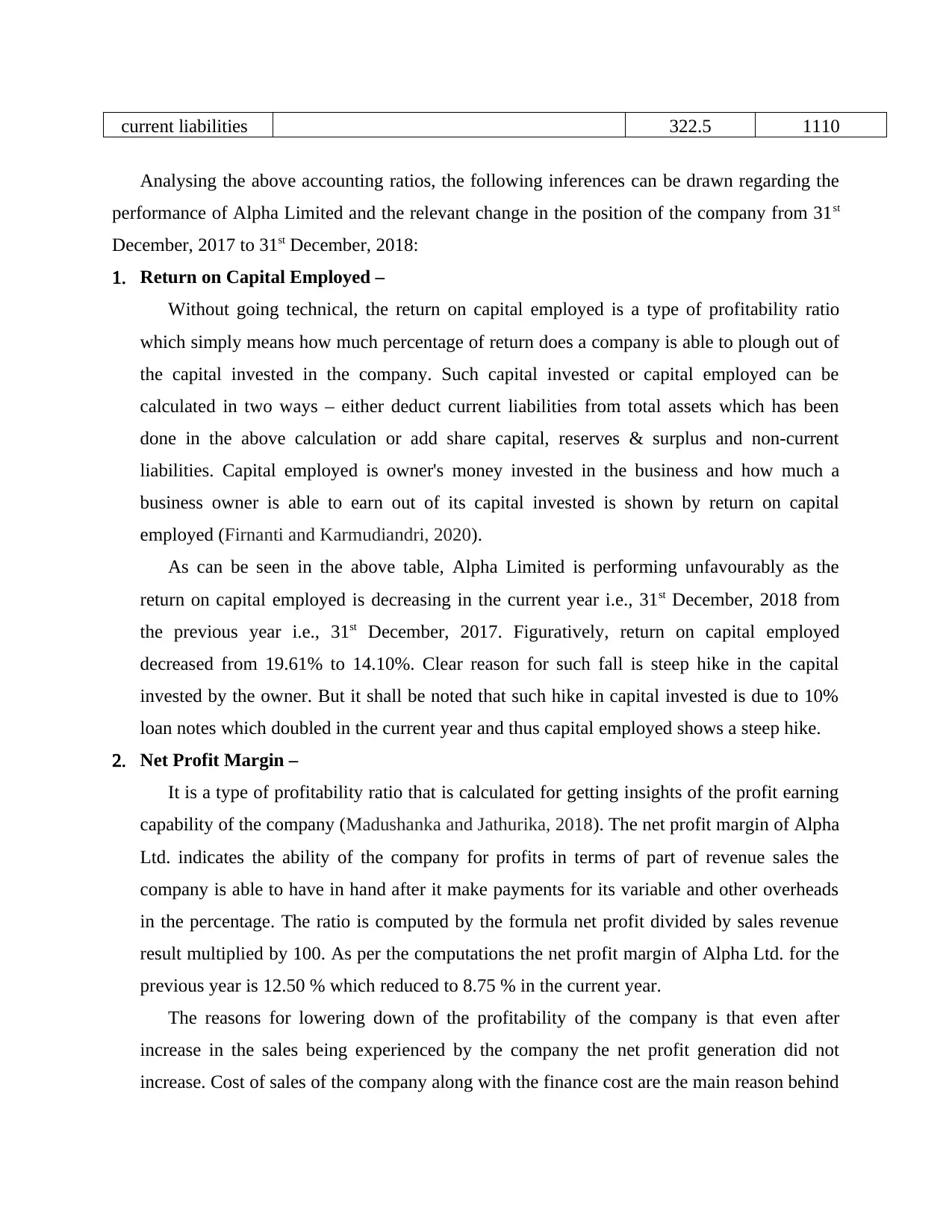
current liabilities 322.5 1110
Analysing the above accounting ratios, the following inferences can be drawn regarding the
performance of Alpha Limited and the relevant change in the position of the company from 31st
December, 2017 to 31st December, 2018:
1. Return on Capital Employed –
Without going technical, the return on capital employed is a type of profitability ratio
which simply means how much percentage of return does a company is able to plough out of
the capital invested in the company. Such capital invested or capital employed can be
calculated in two ways – either deduct current liabilities from total assets which has been
done in the above calculation or add share capital, reserves & surplus and non-current
liabilities. Capital employed is owner's money invested in the business and how much a
business owner is able to earn out of its capital invested is shown by return on capital
employed (Firnanti and Karmudiandri, 2020).
As can be seen in the above table, Alpha Limited is performing unfavourably as the
return on capital employed is decreasing in the current year i.e., 31st December, 2018 from
the previous year i.e., 31st December, 2017. Figuratively, return on capital employed
decreased from 19.61% to 14.10%. Clear reason for such fall is steep hike in the capital
invested by the owner. But it shall be noted that such hike in capital invested is due to 10%
loan notes which doubled in the current year and thus capital employed shows a steep hike.
2. Net Profit Margin –
It is a type of profitability ratio that is calculated for getting insights of the profit earning
capability of the company (Madushanka and Jathurika, 2018). The net profit margin of Alpha
Ltd. indicates the ability of the company for profits in terms of part of revenue sales the
company is able to have in hand after it make payments for its variable and other overheads
in the percentage. The ratio is computed by the formula net profit divided by sales revenue
result multiplied by 100. As per the computations the net profit margin of Alpha Ltd. for the
previous year is 12.50 % which reduced to 8.75 % in the current year.
The reasons for lowering down of the profitability of the company is that even after
increase in the sales being experienced by the company the net profit generation did not
increase. Cost of sales of the company along with the finance cost are the main reason behind
Analysing the above accounting ratios, the following inferences can be drawn regarding the
performance of Alpha Limited and the relevant change in the position of the company from 31st
December, 2017 to 31st December, 2018:
1. Return on Capital Employed –
Without going technical, the return on capital employed is a type of profitability ratio
which simply means how much percentage of return does a company is able to plough out of
the capital invested in the company. Such capital invested or capital employed can be
calculated in two ways – either deduct current liabilities from total assets which has been
done in the above calculation or add share capital, reserves & surplus and non-current
liabilities. Capital employed is owner's money invested in the business and how much a
business owner is able to earn out of its capital invested is shown by return on capital
employed (Firnanti and Karmudiandri, 2020).
As can be seen in the above table, Alpha Limited is performing unfavourably as the
return on capital employed is decreasing in the current year i.e., 31st December, 2018 from
the previous year i.e., 31st December, 2017. Figuratively, return on capital employed
decreased from 19.61% to 14.10%. Clear reason for such fall is steep hike in the capital
invested by the owner. But it shall be noted that such hike in capital invested is due to 10%
loan notes which doubled in the current year and thus capital employed shows a steep hike.
2. Net Profit Margin –
It is a type of profitability ratio that is calculated for getting insights of the profit earning
capability of the company (Madushanka and Jathurika, 2018). The net profit margin of Alpha
Ltd. indicates the ability of the company for profits in terms of part of revenue sales the
company is able to have in hand after it make payments for its variable and other overheads
in the percentage. The ratio is computed by the formula net profit divided by sales revenue
result multiplied by 100. As per the computations the net profit margin of Alpha Ltd. for the
previous year is 12.50 % which reduced to 8.75 % in the current year.
The reasons for lowering down of the profitability of the company is that even after
increase in the sales being experienced by the company the net profit generation did not
increase. Cost of sales of the company along with the finance cost are the main reason behind
Paraphrase This Document
Need a fresh take? Get an instant paraphrase of this document with our AI Paraphraser
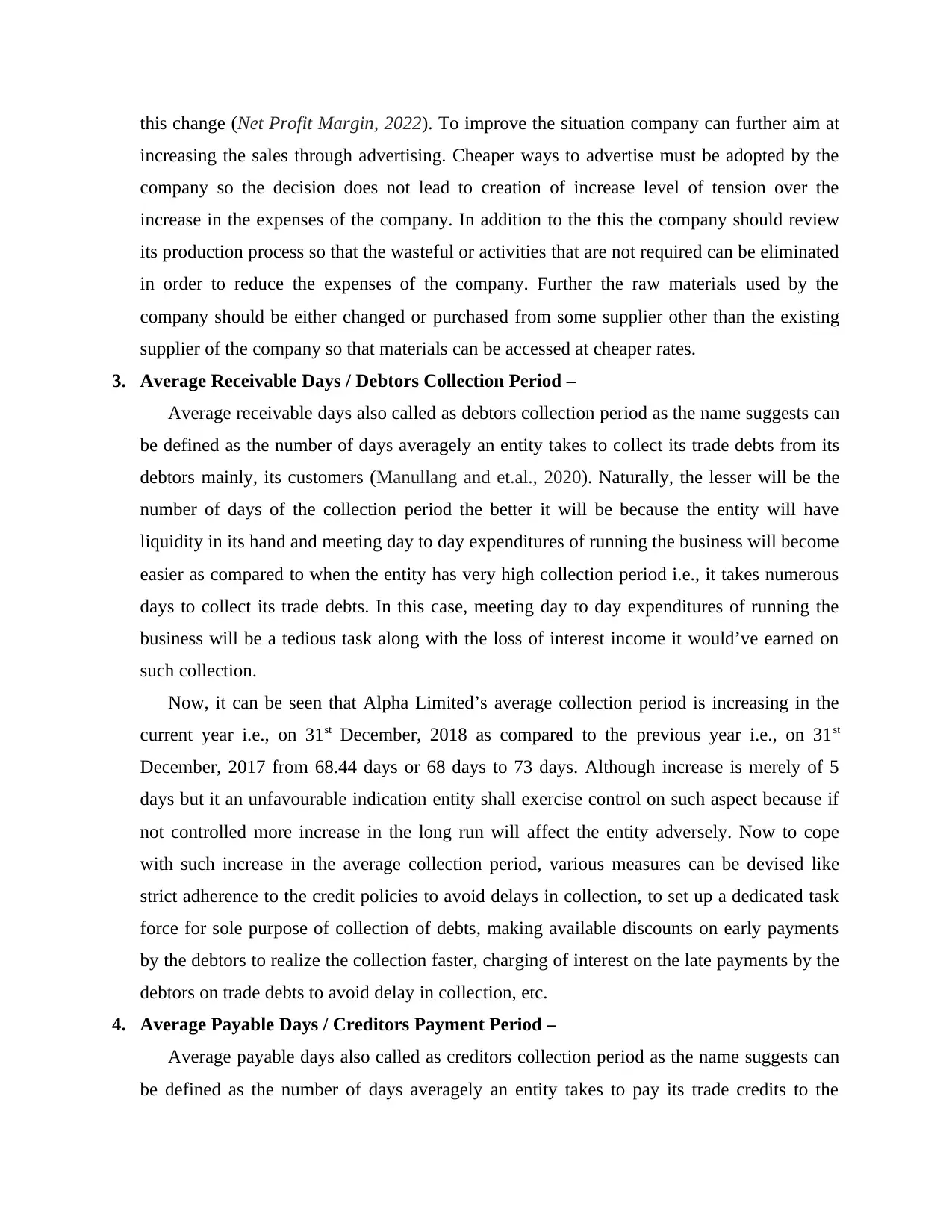
this change (Net Profit Margin, 2022). To improve the situation company can further aim at
increasing the sales through advertising. Cheaper ways to advertise must be adopted by the
company so the decision does not lead to creation of increase level of tension over the
increase in the expenses of the company. In addition to the this the company should review
its production process so that the wasteful or activities that are not required can be eliminated
in order to reduce the expenses of the company. Further the raw materials used by the
company should be either changed or purchased from some supplier other than the existing
supplier of the company so that materials can be accessed at cheaper rates.
3. Average Receivable Days / Debtors Collection Period –
Average receivable days also called as debtors collection period as the name suggests can
be defined as the number of days averagely an entity takes to collect its trade debts from its
debtors mainly, its customers (Manullang and et.al., 2020). Naturally, the lesser will be the
number of days of the collection period the better it will be because the entity will have
liquidity in its hand and meeting day to day expenditures of running the business will become
easier as compared to when the entity has very high collection period i.e., it takes numerous
days to collect its trade debts. In this case, meeting day to day expenditures of running the
business will be a tedious task along with the loss of interest income it would’ve earned on
such collection.
Now, it can be seen that Alpha Limited’s average collection period is increasing in the
current year i.e., on 31st December, 2018 as compared to the previous year i.e., on 31st
December, 2017 from 68.44 days or 68 days to 73 days. Although increase is merely of 5
days but it an unfavourable indication entity shall exercise control on such aspect because if
not controlled more increase in the long run will affect the entity adversely. Now to cope
with such increase in the average collection period, various measures can be devised like
strict adherence to the credit policies to avoid delays in collection, to set up a dedicated task
force for sole purpose of collection of debts, making available discounts on early payments
by the debtors to realize the collection faster, charging of interest on the late payments by the
debtors on trade debts to avoid delay in collection, etc.
4. Average Payable Days / Creditors Payment Period –
Average payable days also called as creditors collection period as the name suggests can
be defined as the number of days averagely an entity takes to pay its trade credits to the
increasing the sales through advertising. Cheaper ways to advertise must be adopted by the
company so the decision does not lead to creation of increase level of tension over the
increase in the expenses of the company. In addition to the this the company should review
its production process so that the wasteful or activities that are not required can be eliminated
in order to reduce the expenses of the company. Further the raw materials used by the
company should be either changed or purchased from some supplier other than the existing
supplier of the company so that materials can be accessed at cheaper rates.
3. Average Receivable Days / Debtors Collection Period –
Average receivable days also called as debtors collection period as the name suggests can
be defined as the number of days averagely an entity takes to collect its trade debts from its
debtors mainly, its customers (Manullang and et.al., 2020). Naturally, the lesser will be the
number of days of the collection period the better it will be because the entity will have
liquidity in its hand and meeting day to day expenditures of running the business will become
easier as compared to when the entity has very high collection period i.e., it takes numerous
days to collect its trade debts. In this case, meeting day to day expenditures of running the
business will be a tedious task along with the loss of interest income it would’ve earned on
such collection.
Now, it can be seen that Alpha Limited’s average collection period is increasing in the
current year i.e., on 31st December, 2018 as compared to the previous year i.e., on 31st
December, 2017 from 68.44 days or 68 days to 73 days. Although increase is merely of 5
days but it an unfavourable indication entity shall exercise control on such aspect because if
not controlled more increase in the long run will affect the entity adversely. Now to cope
with such increase in the average collection period, various measures can be devised like
strict adherence to the credit policies to avoid delays in collection, to set up a dedicated task
force for sole purpose of collection of debts, making available discounts on early payments
by the debtors to realize the collection faster, charging of interest on the late payments by the
debtors on trade debts to avoid delay in collection, etc.
4. Average Payable Days / Creditors Payment Period –
Average payable days also called as creditors collection period as the name suggests can
be defined as the number of days averagely an entity takes to pay its trade credits to the
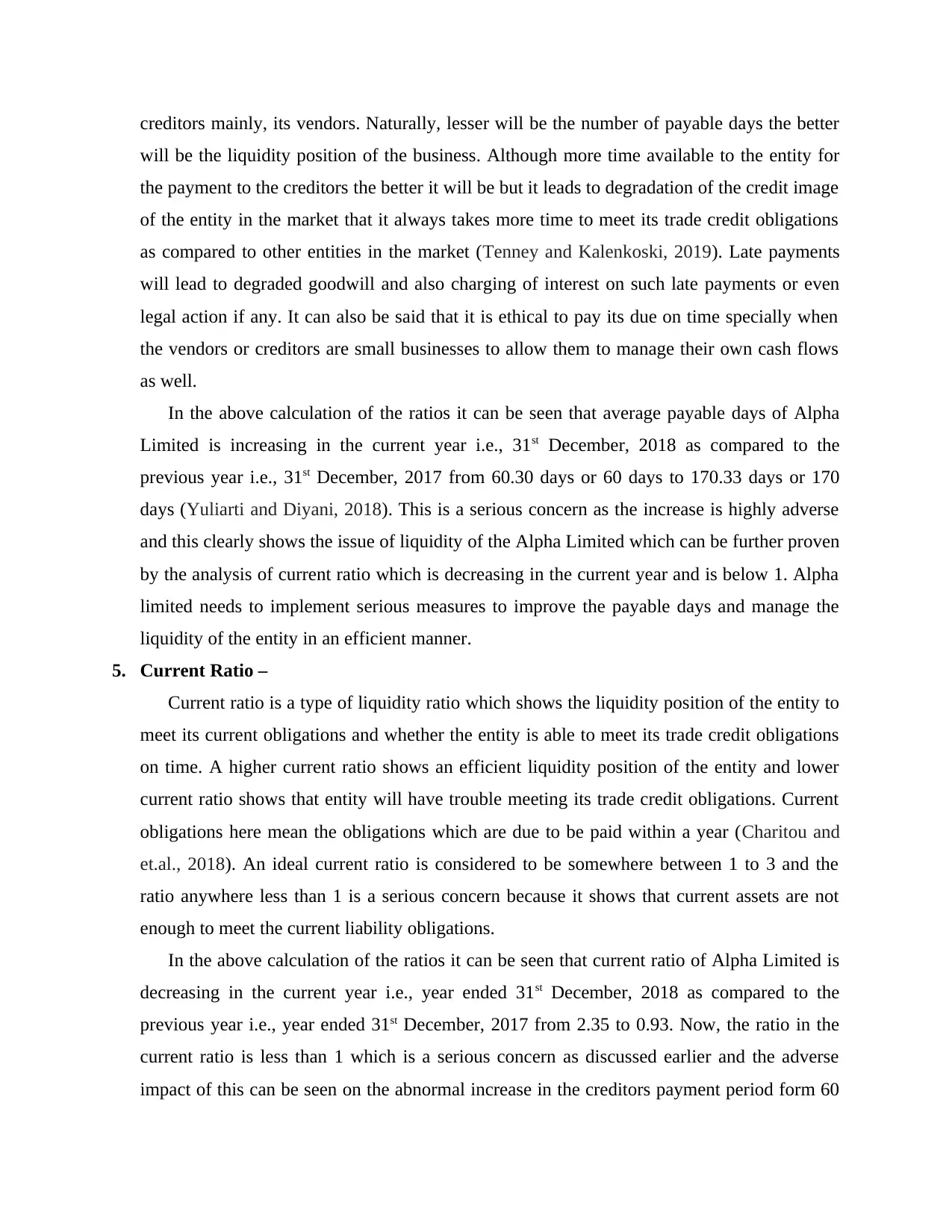
creditors mainly, its vendors. Naturally, lesser will be the number of payable days the better
will be the liquidity position of the business. Although more time available to the entity for
the payment to the creditors the better it will be but it leads to degradation of the credit image
of the entity in the market that it always takes more time to meet its trade credit obligations
as compared to other entities in the market (Tenney and Kalenkoski, 2019). Late payments
will lead to degraded goodwill and also charging of interest on such late payments or even
legal action if any. It can also be said that it is ethical to pay its due on time specially when
the vendors or creditors are small businesses to allow them to manage their own cash flows
as well.
In the above calculation of the ratios it can be seen that average payable days of Alpha
Limited is increasing in the current year i.e., 31st December, 2018 as compared to the
previous year i.e., 31st December, 2017 from 60.30 days or 60 days to 170.33 days or 170
days (Yuliarti and Diyani, 2018). This is a serious concern as the increase is highly adverse
and this clearly shows the issue of liquidity of the Alpha Limited which can be further proven
by the analysis of current ratio which is decreasing in the current year and is below 1. Alpha
limited needs to implement serious measures to improve the payable days and manage the
liquidity of the entity in an efficient manner.
5. Current Ratio –
Current ratio is a type of liquidity ratio which shows the liquidity position of the entity to
meet its current obligations and whether the entity is able to meet its trade credit obligations
on time. A higher current ratio shows an efficient liquidity position of the entity and lower
current ratio shows that entity will have trouble meeting its trade credit obligations. Current
obligations here mean the obligations which are due to be paid within a year (Charitou and
et.al., 2018). An ideal current ratio is considered to be somewhere between 1 to 3 and the
ratio anywhere less than 1 is a serious concern because it shows that current assets are not
enough to meet the current liability obligations.
In the above calculation of the ratios it can be seen that current ratio of Alpha Limited is
decreasing in the current year i.e., year ended 31st December, 2018 as compared to the
previous year i.e., year ended 31st December, 2017 from 2.35 to 0.93. Now, the ratio in the
current ratio is less than 1 which is a serious concern as discussed earlier and the adverse
impact of this can be seen on the abnormal increase in the creditors payment period form 60
will be the liquidity position of the business. Although more time available to the entity for
the payment to the creditors the better it will be but it leads to degradation of the credit image
of the entity in the market that it always takes more time to meet its trade credit obligations
as compared to other entities in the market (Tenney and Kalenkoski, 2019). Late payments
will lead to degraded goodwill and also charging of interest on such late payments or even
legal action if any. It can also be said that it is ethical to pay its due on time specially when
the vendors or creditors are small businesses to allow them to manage their own cash flows
as well.
In the above calculation of the ratios it can be seen that average payable days of Alpha
Limited is increasing in the current year i.e., 31st December, 2018 as compared to the
previous year i.e., 31st December, 2017 from 60.30 days or 60 days to 170.33 days or 170
days (Yuliarti and Diyani, 2018). This is a serious concern as the increase is highly adverse
and this clearly shows the issue of liquidity of the Alpha Limited which can be further proven
by the analysis of current ratio which is decreasing in the current year and is below 1. Alpha
limited needs to implement serious measures to improve the payable days and manage the
liquidity of the entity in an efficient manner.
5. Current Ratio –
Current ratio is a type of liquidity ratio which shows the liquidity position of the entity to
meet its current obligations and whether the entity is able to meet its trade credit obligations
on time. A higher current ratio shows an efficient liquidity position of the entity and lower
current ratio shows that entity will have trouble meeting its trade credit obligations. Current
obligations here mean the obligations which are due to be paid within a year (Charitou and
et.al., 2018). An ideal current ratio is considered to be somewhere between 1 to 3 and the
ratio anywhere less than 1 is a serious concern because it shows that current assets are not
enough to meet the current liability obligations.
In the above calculation of the ratios it can be seen that current ratio of Alpha Limited is
decreasing in the current year i.e., year ended 31st December, 2018 as compared to the
previous year i.e., year ended 31st December, 2017 from 2.35 to 0.93. Now, the ratio in the
current ratio is less than 1 which is a serious concern as discussed earlier and the adverse
impact of this can be seen on the abnormal increase in the creditors payment period form 60
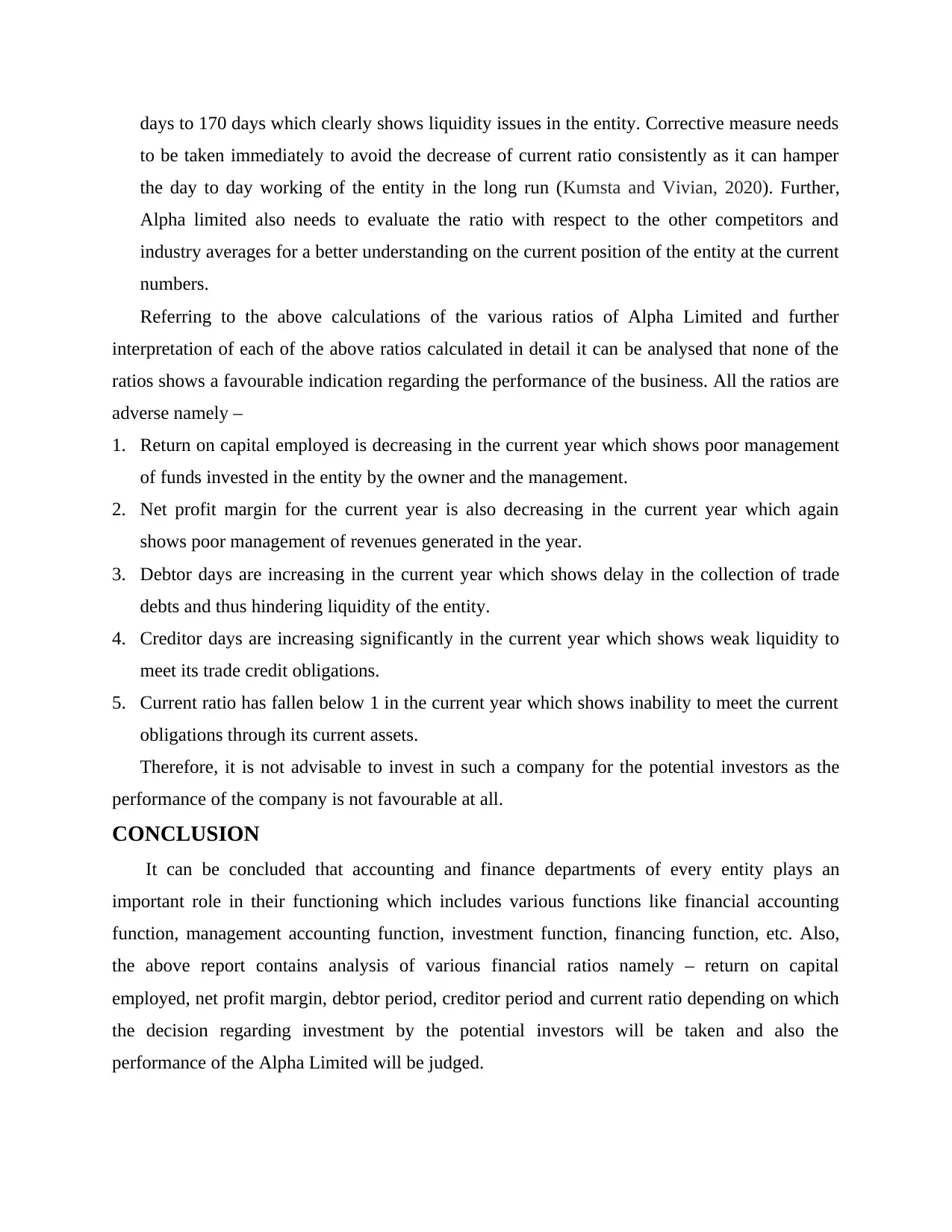
days to 170 days which clearly shows liquidity issues in the entity. Corrective measure needs
to be taken immediately to avoid the decrease of current ratio consistently as it can hamper
the day to day working of the entity in the long run (Kumsta and Vivian, 2020). Further,
Alpha limited also needs to evaluate the ratio with respect to the other competitors and
industry averages for a better understanding on the current position of the entity at the current
numbers.
Referring to the above calculations of the various ratios of Alpha Limited and further
interpretation of each of the above ratios calculated in detail it can be analysed that none of the
ratios shows a favourable indication regarding the performance of the business. All the ratios are
adverse namely –
1. Return on capital employed is decreasing in the current year which shows poor management
of funds invested in the entity by the owner and the management.
2. Net profit margin for the current year is also decreasing in the current year which again
shows poor management of revenues generated in the year.
3. Debtor days are increasing in the current year which shows delay in the collection of trade
debts and thus hindering liquidity of the entity.
4. Creditor days are increasing significantly in the current year which shows weak liquidity to
meet its trade credit obligations.
5. Current ratio has fallen below 1 in the current year which shows inability to meet the current
obligations through its current assets.
Therefore, it is not advisable to invest in such a company for the potential investors as the
performance of the company is not favourable at all.
CONCLUSION
It can be concluded that accounting and finance departments of every entity plays an
important role in their functioning which includes various functions like financial accounting
function, management accounting function, investment function, financing function, etc. Also,
the above report contains analysis of various financial ratios namely – return on capital
employed, net profit margin, debtor period, creditor period and current ratio depending on which
the decision regarding investment by the potential investors will be taken and also the
performance of the Alpha Limited will be judged.
to be taken immediately to avoid the decrease of current ratio consistently as it can hamper
the day to day working of the entity in the long run (Kumsta and Vivian, 2020). Further,
Alpha limited also needs to evaluate the ratio with respect to the other competitors and
industry averages for a better understanding on the current position of the entity at the current
numbers.
Referring to the above calculations of the various ratios of Alpha Limited and further
interpretation of each of the above ratios calculated in detail it can be analysed that none of the
ratios shows a favourable indication regarding the performance of the business. All the ratios are
adverse namely –
1. Return on capital employed is decreasing in the current year which shows poor management
of funds invested in the entity by the owner and the management.
2. Net profit margin for the current year is also decreasing in the current year which again
shows poor management of revenues generated in the year.
3. Debtor days are increasing in the current year which shows delay in the collection of trade
debts and thus hindering liquidity of the entity.
4. Creditor days are increasing significantly in the current year which shows weak liquidity to
meet its trade credit obligations.
5. Current ratio has fallen below 1 in the current year which shows inability to meet the current
obligations through its current assets.
Therefore, it is not advisable to invest in such a company for the potential investors as the
performance of the company is not favourable at all.
CONCLUSION
It can be concluded that accounting and finance departments of every entity plays an
important role in their functioning which includes various functions like financial accounting
function, management accounting function, investment function, financing function, etc. Also,
the above report contains analysis of various financial ratios namely – return on capital
employed, net profit margin, debtor period, creditor period and current ratio depending on which
the decision regarding investment by the potential investors will be taken and also the
performance of the Alpha Limited will be judged.
Secure Best Marks with AI Grader
Need help grading? Try our AI Grader for instant feedback on your assignments.
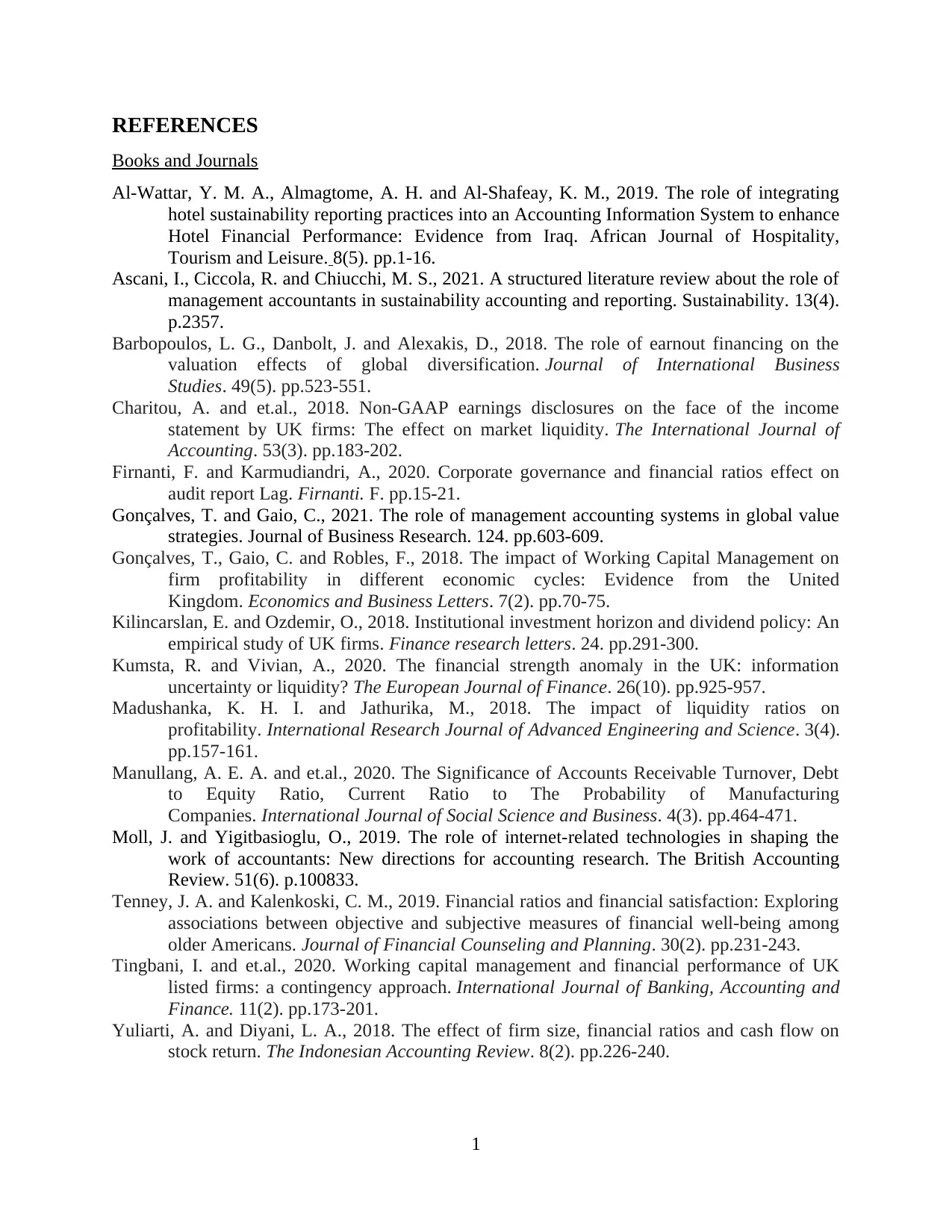
REFERENCES
Books and Journals
Al-Wattar, Y. M. A., Almagtome, A. H. and Al-Shafeay, K. M., 2019. The role of integrating
hotel sustainability reporting practices into an Accounting Information System to enhance
Hotel Financial Performance: Evidence from Iraq. African Journal of Hospitality,
Tourism and Leisure. 8(5). pp.1-16.
Ascani, I., Ciccola, R. and Chiucchi, M. S., 2021. A structured literature review about the role of
management accountants in sustainability accounting and reporting. Sustainability. 13(4).
p.2357.
Barbopoulos, L. G., Danbolt, J. and Alexakis, D., 2018. The role of earnout financing on the
valuation effects of global diversification. Journal of International Business
Studies. 49(5). pp.523-551.
Charitou, A. and et.al., 2018. Non-GAAP earnings disclosures on the face of the income
statement by UK firms: The effect on market liquidity. The International Journal of
Accounting. 53(3). pp.183-202.
Firnanti, F. and Karmudiandri, A., 2020. Corporate governance and financial ratios effect on
audit report Lag. Firnanti. F. pp.15-21.
Gonçalves, T. and Gaio, C., 2021. The role of management accounting systems in global value
strategies. Journal of Business Research. 124. pp.603-609.
Gonçalves, T., Gaio, C. and Robles, F., 2018. The impact of Working Capital Management on
firm profitability in different economic cycles: Evidence from the United
Kingdom. Economics and Business Letters. 7(2). pp.70-75.
Kilincarslan, E. and Ozdemir, O., 2018. Institutional investment horizon and dividend policy: An
empirical study of UK firms. Finance research letters. 24. pp.291-300.
Kumsta, R. and Vivian, A., 2020. The financial strength anomaly in the UK: information
uncertainty or liquidity? The European Journal of Finance. 26(10). pp.925-957.
Madushanka, K. H. I. and Jathurika, M., 2018. The impact of liquidity ratios on
profitability. International Research Journal of Advanced Engineering and Science. 3(4).
pp.157-161.
Manullang, A. E. A. and et.al., 2020. The Significance of Accounts Receivable Turnover, Debt
to Equity Ratio, Current Ratio to The Probability of Manufacturing
Companies. International Journal of Social Science and Business. 4(3). pp.464-471.
Moll, J. and Yigitbasioglu, O., 2019. The role of internet-related technologies in shaping the
work of accountants: New directions for accounting research. The British Accounting
Review. 51(6). p.100833.
Tenney, J. A. and Kalenkoski, C. M., 2019. Financial ratios and financial satisfaction: Exploring
associations between objective and subjective measures of financial well-being among
older Americans. Journal of Financial Counseling and Planning. 30(2). pp.231-243.
Tingbani, I. and et.al., 2020. Working capital management and financial performance of UK
listed firms: a contingency approach. International Journal of Banking, Accounting and
Finance. 11(2). pp.173-201.
Yuliarti, A. and Diyani, L. A., 2018. The effect of firm size, financial ratios and cash flow on
stock return. The Indonesian Accounting Review. 8(2). pp.226-240.
1
Books and Journals
Al-Wattar, Y. M. A., Almagtome, A. H. and Al-Shafeay, K. M., 2019. The role of integrating
hotel sustainability reporting practices into an Accounting Information System to enhance
Hotel Financial Performance: Evidence from Iraq. African Journal of Hospitality,
Tourism and Leisure. 8(5). pp.1-16.
Ascani, I., Ciccola, R. and Chiucchi, M. S., 2021. A structured literature review about the role of
management accountants in sustainability accounting and reporting. Sustainability. 13(4).
p.2357.
Barbopoulos, L. G., Danbolt, J. and Alexakis, D., 2018. The role of earnout financing on the
valuation effects of global diversification. Journal of International Business
Studies. 49(5). pp.523-551.
Charitou, A. and et.al., 2018. Non-GAAP earnings disclosures on the face of the income
statement by UK firms: The effect on market liquidity. The International Journal of
Accounting. 53(3). pp.183-202.
Firnanti, F. and Karmudiandri, A., 2020. Corporate governance and financial ratios effect on
audit report Lag. Firnanti. F. pp.15-21.
Gonçalves, T. and Gaio, C., 2021. The role of management accounting systems in global value
strategies. Journal of Business Research. 124. pp.603-609.
Gonçalves, T., Gaio, C. and Robles, F., 2018. The impact of Working Capital Management on
firm profitability in different economic cycles: Evidence from the United
Kingdom. Economics and Business Letters. 7(2). pp.70-75.
Kilincarslan, E. and Ozdemir, O., 2018. Institutional investment horizon and dividend policy: An
empirical study of UK firms. Finance research letters. 24. pp.291-300.
Kumsta, R. and Vivian, A., 2020. The financial strength anomaly in the UK: information
uncertainty or liquidity? The European Journal of Finance. 26(10). pp.925-957.
Madushanka, K. H. I. and Jathurika, M., 2018. The impact of liquidity ratios on
profitability. International Research Journal of Advanced Engineering and Science. 3(4).
pp.157-161.
Manullang, A. E. A. and et.al., 2020. The Significance of Accounts Receivable Turnover, Debt
to Equity Ratio, Current Ratio to The Probability of Manufacturing
Companies. International Journal of Social Science and Business. 4(3). pp.464-471.
Moll, J. and Yigitbasioglu, O., 2019. The role of internet-related technologies in shaping the
work of accountants: New directions for accounting research. The British Accounting
Review. 51(6). p.100833.
Tenney, J. A. and Kalenkoski, C. M., 2019. Financial ratios and financial satisfaction: Exploring
associations between objective and subjective measures of financial well-being among
older Americans. Journal of Financial Counseling and Planning. 30(2). pp.231-243.
Tingbani, I. and et.al., 2020. Working capital management and financial performance of UK
listed firms: a contingency approach. International Journal of Banking, Accounting and
Finance. 11(2). pp.173-201.
Yuliarti, A. and Diyani, L. A., 2018. The effect of firm size, financial ratios and cash flow on
stock return. The Indonesian Accounting Review. 8(2). pp.226-240.
1
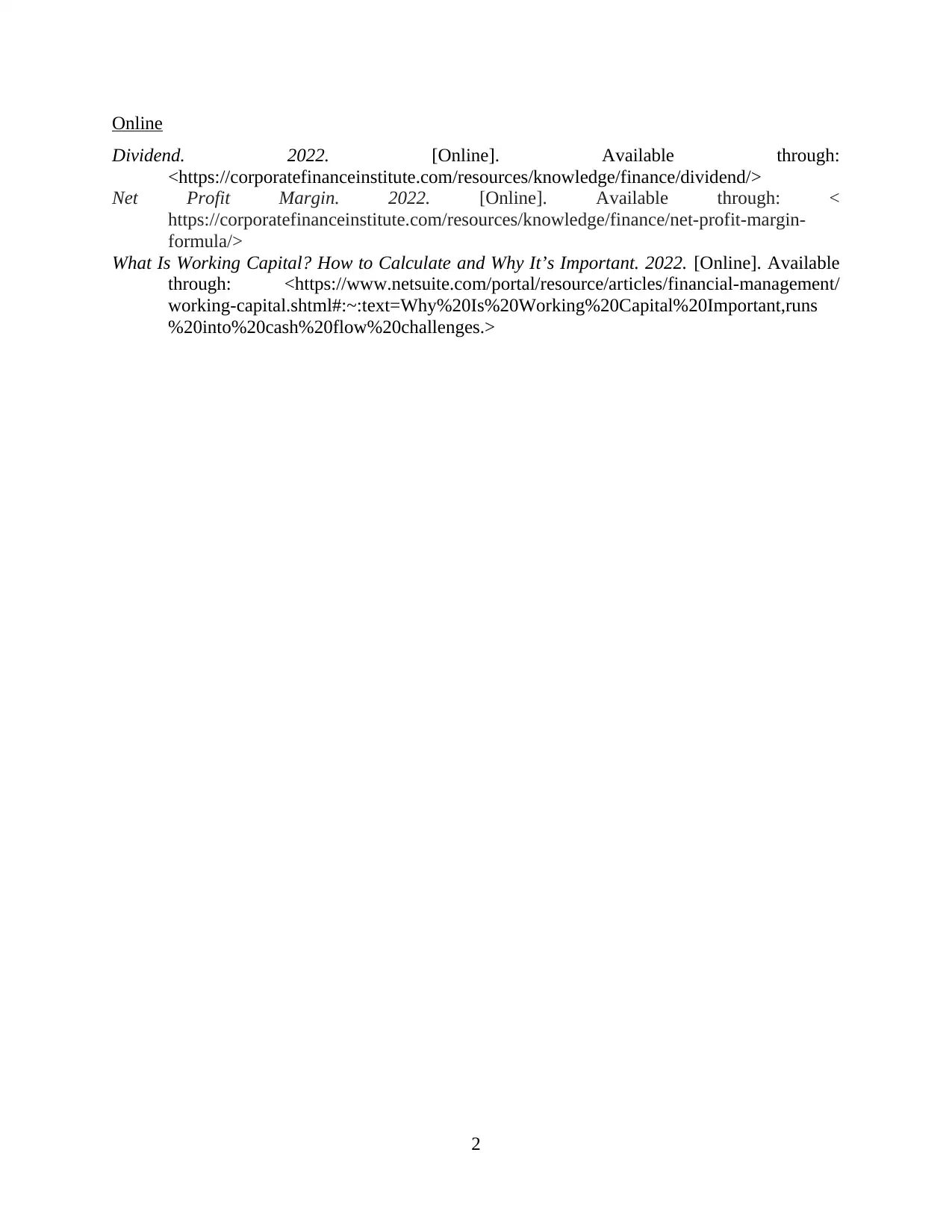
Online
Dividend. 2022. [Online]. Available through:
<https://corporatefinanceinstitute.com/resources/knowledge/finance/dividend/>
Net Profit Margin. 2022. [Online]. Available through: <
https://corporatefinanceinstitute.com/resources/knowledge/finance/net-profit-margin-
formula/>
What Is Working Capital? How to Calculate and Why It’s Important. 2022. [Online]. Available
through: <https://www.netsuite.com/portal/resource/articles/financial-management/
working-capital.shtml#:~:text=Why%20Is%20Working%20Capital%20Important,runs
%20into%20cash%20flow%20challenges.>
2
Dividend. 2022. [Online]. Available through:
<https://corporatefinanceinstitute.com/resources/knowledge/finance/dividend/>
Net Profit Margin. 2022. [Online]. Available through: <
https://corporatefinanceinstitute.com/resources/knowledge/finance/net-profit-margin-
formula/>
What Is Working Capital? How to Calculate and Why It’s Important. 2022. [Online]. Available
through: <https://www.netsuite.com/portal/resource/articles/financial-management/
working-capital.shtml#:~:text=Why%20Is%20Working%20Capital%20Important,runs
%20into%20cash%20flow%20challenges.>
2
1 out of 12
Related Documents
Your All-in-One AI-Powered Toolkit for Academic Success.
+13062052269
info@desklib.com
Available 24*7 on WhatsApp / Email
![[object Object]](/_next/static/media/star-bottom.7253800d.svg)
Unlock your academic potential
© 2024 | Zucol Services PVT LTD | All rights reserved.




